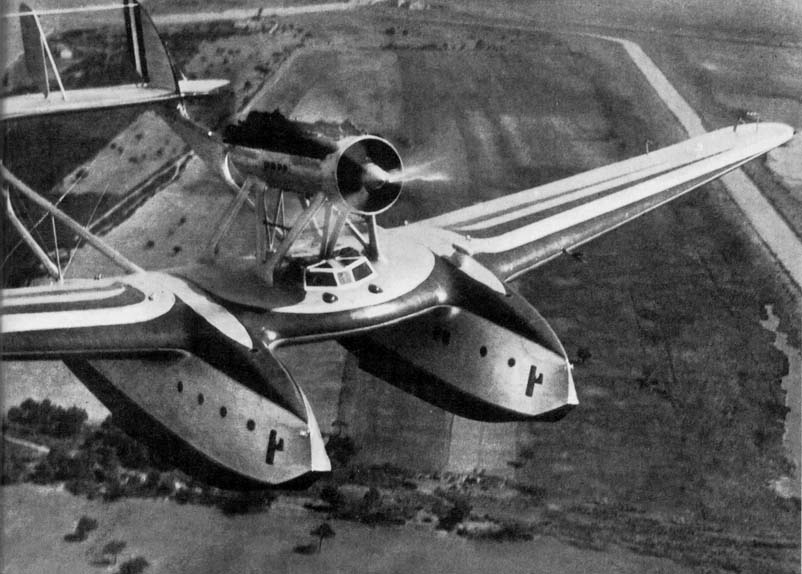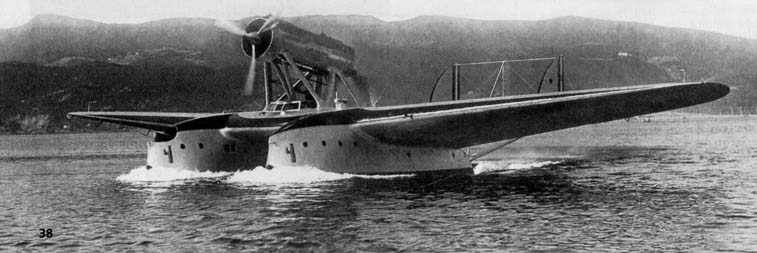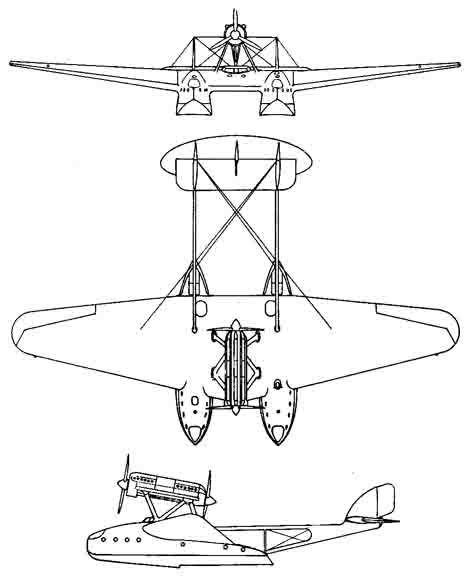


Aircraft of the Month for July 2000

SIAI Marchetti SM.55
by Alex Stoll




In 1929, Francesco De Pinedo, who had flown 34,000 miles from Italy to Japan and back in 1925, flew an improved SM.55, the Santa Maria (named after Colombus' flagship), 28,000 miles to all the countires on the North Atlantic rim. In September 1930 Italo Balbo led 14 SM.55s 6500 mi from Rome to Rio de Janeiro and back. In 1932, a SM.55 purchased by the USSR flew 14,000 mi from the Savoia-Marchetti factory outside Florence across Sibera to Petropavlovsk on the Kamchatka Peninsula. From 1 July - 21 August, 1933, Balbo led 24 SM.55s on a round trip from Rome to Chicago for the Chicago World's Fair Exposition, a distance of almost 11,500 mi.

| More photos |
|---|
| Close-up of the Asso 750 installation on a SM.55X SM.55X's at Orbetello (outside Rome) before their flight to Chicago in 1933 Leaving in formation SM.55X's flying in formation |
 (Note the facist symbols at the bow of the hulls on this SM.55X) | ||
| Prototype | 1923 | Two 224kW (300hp) Fiat A.12 bis engines; max speed 190km/h |
| ? | 1925 | Patrol bomber and mine layer; two 298kW (400hp) Lorraine-Dietrich engines |
| M | 1926 | Initial military version; two 373kW (500hp) Isotta Fraschini 12-cyl Asso (Ace) engines; max speed 210 km/h |
| P | 1928 | Passenger version |
| A | 1930 | First trans-atlantic version; two 418kW (560hp) Fiat A.22R engines |
| C | 1932 | Commericial version; two 522kW (700hp) Fiat A.24R engines; max speed 240 km/h |
| X | 1933 | Tenth version; incorperated many design improvements, including three-blade props, smoother fairing, and experimental concave hull bottoms (more info below) |
| Piaggio 9 | ? | All-metal version; 7% lighter but 19 km/h (10 kts; 12mph) slower and with a 457m (1500ft) lower service ceiling |
SM.55X Specifications | |
|---|---|
| Type | Twin-hull monoplane flying boat |
| Powerplant | Two 18-cyl. Isotta Fraschini Asso 750 engines, 597 kW (800hp) each |
| Accommodation | Two pilots, a radioman and a flight engineer/mechanic |
| Max fuel | 3780L (1000 gal) carried in seven tanks in each hull |
| Performance | |
| Max speed at sea level | 280 km/h (151 kts; 174 mph) |
| Cruise speed | 217 km/h (117 kts; 135 mph) |
| Service ceiling | 5000m (16,400 ft) |
| Ceiling, fully loaded | 4115m (13,500 ft) |
| Range | 3000km (1620 nm; 1863 mi) |
| Fuel consumption during cruise | 30 gph per engine |
| Takeoff speed | Just under 113 km/h (61 kts; 70 mph) |
| Weights | |
| Empty | 5760 kg (12,686 lb) |
| MTOW | 8263 kg (18,200 lb) |
| Dimensions | |
| Wingspan | 24m (78 ft 8.5 in) |
| Wing area | 93m² (990 sq ft) |